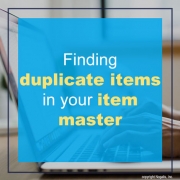Finding Duplicate Items in your Item Master
If you find duplicate items in your item master and want to reduce clutter, here are some tips:
- Items can have multiple ways of being identified. Many items are manufactured by different companies and they really are the same inventory item as they are interchangeable in your warehouse.
- Use the main manufacturer information on your item master – or the manufacturer information that your main supplier uses for the item.
- If different vendors provide different manufacturers items for the same item, then on PO13- Vendor Item, indicate the vendor and their item number and their manufacturer information there. This information will default onto a PO when ordering from one vendor vs. a different vendor. This allows you to have a single item that could be manufactured or supplied by multiple vendors and manufacturers.
- If there are multiple manufacturers or vendors for the item, then having a way to compare those is also important. Lawson does provide the ability to store manufacturer information in multiple ways – on the item master, on the item location record if a particular item for a location was being purchased from a different Vendor , and on the Vendor Item record. That means there are potentially multiple ways to store and find the manufacturer information for a particular item.
- POs are another place where manufacturer information for an item is stored so even if you are not storing the manufacturer information on the item master, you might still be able to create a cross reference by looking at your PO line data as well.
- Once all the options for manufacturer information are exhausted, then the remaining items will need to be matched item by item by description. This can be very time consuming especially since Lawson has a small description field which often requires considerable abbreviation of words in the description.
- Some additional considerations are to use the any of the other ways items might be classified This includes: generic name, Inventory classes, GL Categories, commodity codes and possibly SKUs if any of these are being stored.



